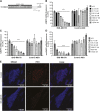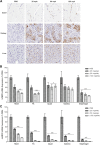Identification and characterization of modified antisense oligonucleotides targeting DMPK in mice and nonhuman primates for the treatment of myotonic dystrophy type 1
- PMID: 26330536
- PMCID: PMC4613955
- DOI: 10.1124/jpet.115.226969
Identification and characterization of modified antisense oligonucleotides targeting DMPK in mice and nonhuman primates for the treatment of myotonic dystrophy type 1
Abstract
Myotonic dystrophy type 1 (DM1) is the most common form of muscular dystrophy in adults. DM1 is caused by an expanded CTG repeat in the 3'-untranslated region of DMPK, the gene encoding dystrophia myotonica protein kinase (DMPK). Antisense oligonucleotides (ASOs) containing 2',4'-constrained ethyl-modified (cEt) residues exhibit a significantly increased RNA binding affinity and in vivo potency relative to those modified with other 2'-chemistries, which we speculated could translate to enhanced activity in extrahepatic tissues, such as muscle. Here, we describe the design and characterization of a cEt gapmer DMPK ASO (ISIS 486178), with potent activity in vitro and in vivo against mouse, monkey, and human DMPK. Systemic delivery of unformulated ISIS 486718 to wild-type mice decreased DMPK mRNA levels by up to 90% in liver and skeletal muscle. Similarly, treatment of either human DMPK transgenic mice or cynomolgus monkeys with ISIS 486178 led to up to 70% inhibition of DMPK in multiple skeletal muscles and ∼50% in cardiac muscle in both species. Importantly, inhibition of DMPK was well tolerated and was not associated with any skeletal muscle or cardiac toxicity. Also interesting was the demonstration that the inhibition of DMPK mRNA levels in muscle was maintained for up to 16 and 13 weeks post-treatment in mice and monkeys, respectively. These results demonstrate that cEt-modified ASOs show potent activity in skeletal muscle, and that this attractive therapeutic approach warrants further clinical investigation to inhibit the gain-of-function toxic RNA underlying the pathogenesis of DM1.
Copyright © 2015 by The American Society for Pharmacology and Experimental Therapeutics.
Figures





Similar articles
-
Systemic therapy in an RNA toxicity mouse model with an antisense oligonucleotide therapy targeting a non-CUG sequence within the DMPK 3'UTR RNA.Hum Mol Genet. 2020 Jun 3;29(9):1440-1453. doi: 10.1093/hmg/ddaa060. Hum Mol Genet. 2020. PMID: 32242217 Free PMC article.
-
Systemic Evaluation of Chimeric LNA/2'-O-Methyl Steric Blockers for Myotonic Dystrophy Type 1 Therapy.Nucleic Acid Ther. 2020 Apr;30(2):80-93. doi: 10.1089/nat.2019.0811. Epub 2019 Dec 23. Nucleic Acid Ther. 2020. PMID: 31873063 Free PMC article.
-
Antisense oligonucleotides as a potential treatment for brain deficits observed in myotonic dystrophy type 1.Gene Ther. 2022 Dec;29(12):698-709. doi: 10.1038/s41434-022-00316-7. Epub 2022 Jan 25. Gene Ther. 2022. PMID: 35075265 Free PMC article.
-
Recent Progress and Challenges in the Development of Antisense Therapies for Myotonic Dystrophy Type 1.Int J Mol Sci. 2022 Nov 1;23(21):13359. doi: 10.3390/ijms232113359. Int J Mol Sci. 2022. PMID: 36362145 Free PMC article. Review.
-
Molecular Therapies for Myotonic Dystrophy Type 1: From Small Drugs to Gene Editing.Int J Mol Sci. 2022 Apr 21;23(9):4622. doi: 10.3390/ijms23094622. Int J Mol Sci. 2022. PMID: 35563013 Free PMC article. Review.
Cited by
-
MicroRNA-Based Therapeutic Perspectives in Myotonic Dystrophy.Int J Mol Sci. 2019 Nov 9;20(22):5600. doi: 10.3390/ijms20225600. Int J Mol Sci. 2019. PMID: 31717488 Free PMC article. Review.
-
miR-23b and miR-218 silencing increase Muscleblind-like expression and alleviate myotonic dystrophy phenotypes in mammalian models.Nat Commun. 2018 Jun 26;9(1):2482. doi: 10.1038/s41467-018-04892-4. Nat Commun. 2018. PMID: 29946070 Free PMC article.
-
Long Noncoding RNA in Cancer: Wiring Signaling Circuitry.Trends Cell Biol. 2018 Apr;28(4):287-301. doi: 10.1016/j.tcb.2017.11.008. Epub 2017 Dec 20. Trends Cell Biol. 2018. PMID: 29274663 Free PMC article. Review.
-
FORCE platform overcomes barriers of oligonucleotide delivery to muscle and corrects myotonic dystrophy features in preclinical models.Commun Med (Lond). 2025 Jan 18;5(1):22. doi: 10.1038/s43856-025-00733-w. Commun Med (Lond). 2025. PMID: 39827287 Free PMC article.
-
Peptide-Conjugated PMOs for the Treatment of Myotonic Dystrophy.Methods Mol Biol. 2023;2587:209-237. doi: 10.1007/978-1-0716-2772-3_13. Methods Mol Biol. 2023. PMID: 36401033
References
-
- Agrawal S, Zhao Q, Jiang Z, Oliver C, Giles H, Heath J, Serota D. (1997) Toxicologic effects of an oligodeoxynucleotide phosphorothioate and its analogs following intravenous administration in rats. Antisense Nucleic Acid Drug Dev 7:575–584. - PubMed
-
- Bennett CF, Swayze EE. (2010) RNA targeting therapeutics: molecular mechanisms of antisense oligonucleotides as a therapeutic platform. Annu Rev Pharmacol Toxicol 50:259–293. - PubMed
-
- Berul CI, Maguire CT, Gehrmann J, Reddy S. (2000) Progressive atrioventricular conduction block in a mouse myotonic dystrophy model. J Interv Card Electrophysiol 4:351–358. - PubMed
-
- Blake DJ, Weir A, Newey SE, Davies KE. (2002) Function and genetics of dystrophin and dystrophin-related proteins in muscle. Physiol Rev 82:291–329. - PubMed
Publication types
MeSH terms
Substances
Grants and funding
LinkOut - more resources
Full Text Sources
Other Literature Sources

